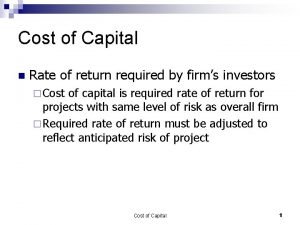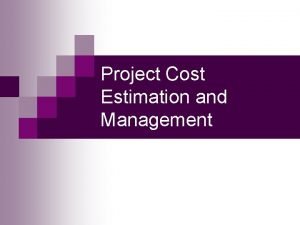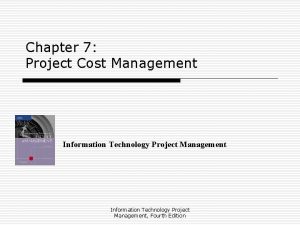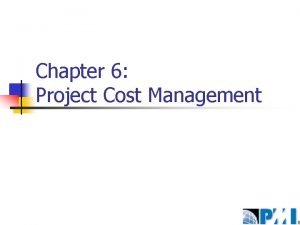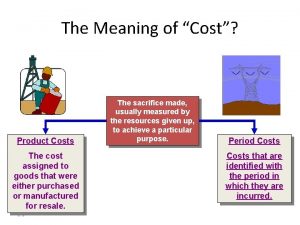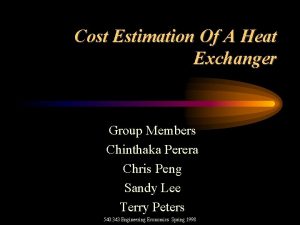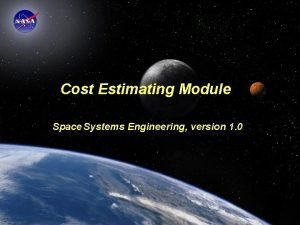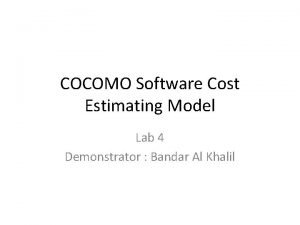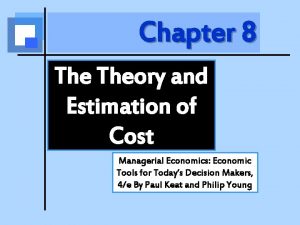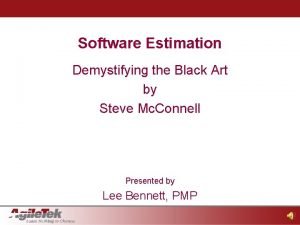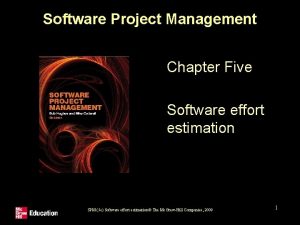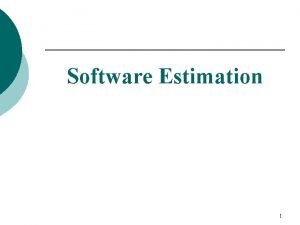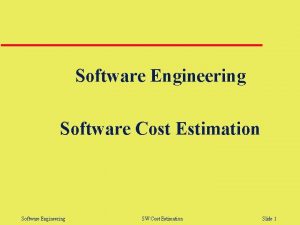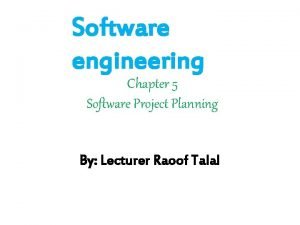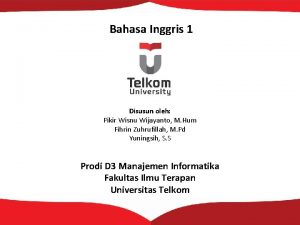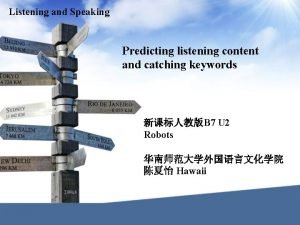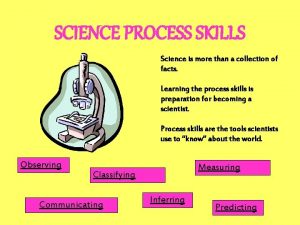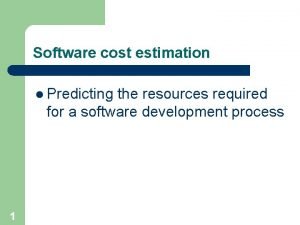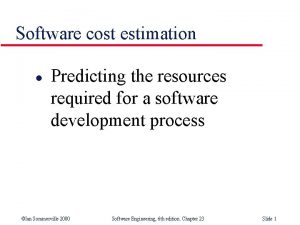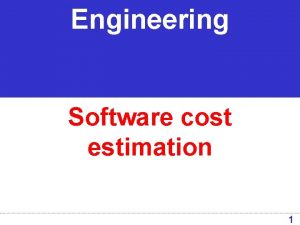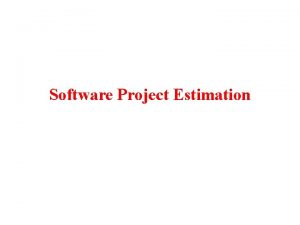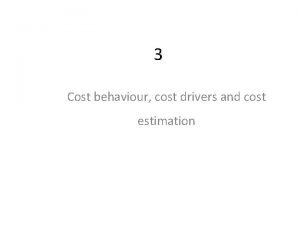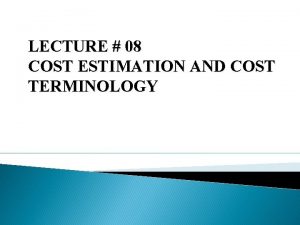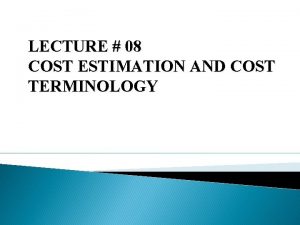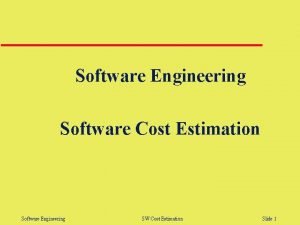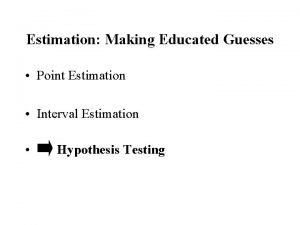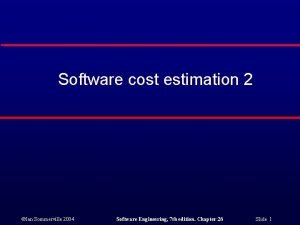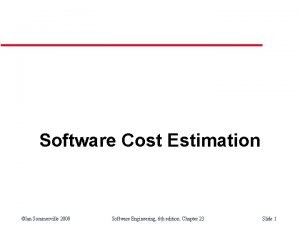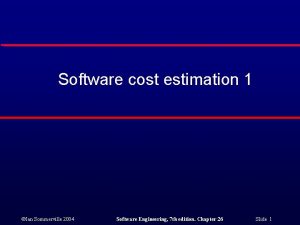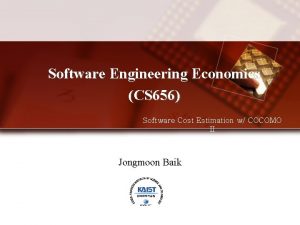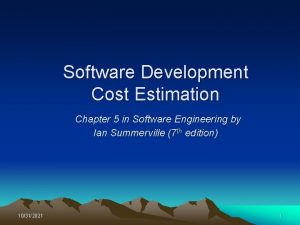Software cost estimation l Predicting the resources required















































- Slides: 47

Software cost estimation l Predicting the resources required for a software development process ©Ian Sommerville 2000 Software Engineering, 6 th edition. Chapter 23 Slide 1

Fundamental estimation questions l l How much effort is required to complete an activity? How much calendar time is needed to complete an activity? What is the total cost of an activity? Project estimation and scheduling are interleaved management activities ©Ian Sommerville 2000 Software Engineering, 6 th edition. Chapter 23 Slide 4

Software cost components l l l Hardware costs Software costs Travel and training costs Effort costs (the dominant factor in most projects) Effort costs must take overheads into account Organization typically has a percentage of direct costs that are allocated to overheads ©Ian Sommerville 2000 Software Engineering, 6 th edition. Chapter 23 Slide 5

Costing and pricing l l l Estimates are made to discover the cost, to the developer, of producing a software system There is not a simple relationship between the development cost and the price charged to the customer Broader organizational, economic, political and business considerations influence the price charged ©Ian Sommerville 2000 Software Engineering, 6 th edition. Chapter 23 Slide 6

Software pricing factors ©Ian Sommerville 2000 Software Engineering, 6 th edition. Chapter 23 Slide 7

23. 1 Programmer productivity l l Measure the rate at which engineers produce software and associated documentation Not quality-oriented measurement Knowing productivity helps predict cost Essentially, measure useful functionality produced per time unit ©Ian Sommerville 2000 Software Engineering, 6 th edition. Chapter 23 Slide 8

Productivity measures l Size related measures • l Time includes time for analysis, design, coding, testing, documentation Function-related measures ©Ian Sommerville 2000 Software Engineering, 6 th edition. Chapter 23 Slide 9

Measurement problems l l l Estimating the size of the measure Estimating the total number of programmer months which have elapsed Estimating contractor productivity (e. g. documentation team) and incorporating this estimate in overall estimate ©Ian Sommerville 2000 Software Engineering, 6 th edition. Chapter 23 Slide 10

Lines of code l What's a line of code? • l l What programs should be counted as part of the system? Assumes linear relationship between system size and volume of documentation ©Ian Sommerville 2000 Software Engineering, 6 th edition. Chapter 23 Slide 11

Productivity comparisons l Comparisons may be misleading • Language used has an impact • The more verbose the programmer, the higher the measured productivity • ©Ian Sommerville 2000 Software Engineering, 6 th edition. Chapter 23 Slide 12

Function points l Based on a combination of program characteristics • • l l external inputs and outputs user interactions external interfaces files used by the system A weight is associated with each of these The function point count is computed by multiplying each raw count by the weight and summing all values ©Ian Sommerville 2000 Software Engineering, 6 th edition. Chapter 23 Slide 15

Function points l l Function point count modified by complexity of the project Adjustments to FPs are very subjective. They depend on the estimator. • l Automatic function-point counting is impossible FPs can be used to estimate LOC depending on the average number of LOC per FP for a given language • • LOC = AVC * number of function points AVC is a language-dependent factor varying from 200 -300 for assemble language to 2 -40 for a 4 GL ©Ian Sommerville 2000 Software Engineering, 6 th edition. Chapter 23 Slide 16

Object points l l l Object points are an alternative function-related measure to function points when 4 Gls or similar languages are used for development Object points are NOT the same as object classes The number of object points in a program is a weighted estimate of • • • The number of separate screens that are displayed The number of reports that are produced by the system The number of 3 GL modules that must be developed to supplement the 4 GL code ©Ian Sommerville 2000 Software Engineering, 6 th edition. Chapter 23 Slide 17

Object point estimation l l Object points easier to estimate from high level spec than are function points They can therefore be estimated at an early point in the development process. At this stage, it is very difficult to estimate the number of lines of code in a system ©Ian Sommerville 2000 Software Engineering, 6 th edition. Chapter 23 Slide 18

Productivity estimates l l Real-time embedded systems, 40 -160 LOC/P-month Systems programs , 150 -400 LOC/P-month Commercial applications, 200 -800 LOC/P-month In object points, productivity has been measured between 4 and 50 object points/month depending on tool support and developer capability ©Ian Sommerville 2000 Software Engineering, 6 th edition. Chapter 23 Slide 19

Factors affecting productivity ©Ian Sommerville 2000 Software Engineering, 6 th edition. Chapter 23 Slide 20

Quality and productivity l l l All metrics based on volume/unit time are flawed because they do not take quality into account Productivity may usually be increased at the cost of quality It is not clear how productivity/quality metrics are related Reuse increases real productivity but not measured productivity Using numeric productivity measures in judging employees is risky If change is constant then an approach based on counting lines of code is not meaningful ©Ian Sommerville 2000 Software Engineering, 6 th edition. Chapter 23 Slide 21

23. 2 Estimation techniques l There is no simple way to make an accurate estimate of the effort required to develop a software system • • • l Initial estimates are based on inadequate information in a user requirements definition The software may run on unfamiliar computers or use new technology The people in the project may be unknown Project cost estimates may be self-fulfilling • The estimate defines the budget and the product is adjusted to meet the budget ©Ian Sommerville 2000 Software Engineering, 6 th edition. Chapter 23 Slide 22

Estimation techniques l l l Algorithmic cost modelling Expert judgement Estimation by analogy Parkinson's Law Pricing to win ©Ian Sommerville 2000 Software Engineering, 6 th edition. Chapter 23 Slide 23

Algorithmic code modelling l l A formulaic approach based on historical cost information and which is generally based on the size of the software Discussed later in this chapter ©Ian Sommerville 2000 Software Engineering, 6 th edition. Chapter 23 Slide 24

Expert judgement l l l One or more experts in both software development and the application domain use their experience to predict software costs. Process iterates until some consensus is reached. Advantages: Relatively cheap estimation method. Can be accurate if experts have direct experience of similar systems Disadvantages: Very inaccurate if there are no experts! ©Ian Sommerville 2000 Software Engineering, 6 th edition. Chapter 23 Slide 25

Estimation by analogy l l l The cost of a project is computed by comparing the project to a similar project in the same application domain Advantages: Accurate if project data available Disadvantages: Impossible if no comparable project has been tackled. Needs systematically maintained cost database ©Ian Sommerville 2000 Software Engineering, 6 th edition. Chapter 23 Slide 26

Pricing to win l l l The project costs whatever the customer has to spend on it Advantages: You get the contract Disadvantages: The probability that the customer gets the system he or she wants is small. Costs do not accurately reflect the work required ©Ian Sommerville 2000 Software Engineering, 6 th edition. Chapter 23 Slide 28

Pricing to win l l This approach may seem unethical and unbusinesslike However, when detailed information is lacking it may be the only appropriate strategy The project cost is agreed on the basis of an outline proposal and the development is constrained by that cost A detailed specification may be negotiated or an evolutionary approach used for system development ©Ian Sommerville 2000 Software Engineering, 6 th edition. Chapter 23 Slide 29

Estimation methods l l l Each method has strengths and weaknesses Estimation should be based on several methods If these do not return approximately the same result, there is insufficient information available Some action should be taken to find out more in order to make more accurate estimates Pricing to win is sometimes the only applicable method ©Ian Sommerville 2000 Software Engineering, 6 th edition. Chapter 23 Slide 33

Experience-based estimates l l Estimating is primarily experience-based However, new methods and technologies may make estimating based on experience inaccurate • • • Object oriented rather than function-oriented development Client-server systems rather than mainframe systems Off the shelf components Component-based software engineering – development for reuse Visual programming, CASE tools and program generators ©Ian Sommerville 2000 Software Engineering, 6 th edition. Chapter 23 Slide 34

23. 3 Algorithmic cost modelling l l l Cost is estimated as a mathematical function of product, project and process attributes whose values are estimated by project managers • Effort = A ´ Size. B ´ M • A is an organisation-dependent constant, B reflects the disproportionate effort for large projects and M is a multiplier reflecting product, process and people attributes Most commonly used product attribute for cost estimation is code size Most models are basically similar but with different values for A, B and M ©Ian Sommerville 2000 Software Engineering, 6 th edition. Chapter 23 Slide 35

Estimation accuracy l l The size of a software system can only be known accurately when it is finished Several factors influence the final size • • • l l l Use of COTS and components Programming language Distribution of system As the development process progresses then the size estimate becomes more accurate B and M are subjective estimates (or based on subjective estimates) Calibrate ©Ian Sommerville 2000 Software Engineering, 6 th edition. Chapter 23 Slide 36

Estimate uncertainty ©Ian Sommerville 2000 Software Engineering, 6 th edition. Chapter 23 Slide 37

23. 3. 1 The COCOMO model l l l An empirical model based on project experience Well-documented, ‘independent’ model which is not tied to a specific software vendor Public domain Supported by tools Long history from initial version published in 1981 (COCOMO-81) through various instantiations to COCOMO 2 takes into account different approaches to software development, reuse, etc. ©Ian Sommerville 2000 Software Engineering, 6 th edition. Chapter 23 Slide 38

COCOMO 2 levels l l COCOMO 2 is a 3 level model that allows increasingly detailed estimates to be prepared as development progresses Early prototyping level • l Early design level • l Estimates based on object points and a simple formula is used for effort estimation Estimates based on function points that are then translated to LOC Post-architecture level • Estimates based on lines of source code ©Ian Sommerville 2000 Software Engineering, 6 th edition. Chapter 23 Slide 40

Early prototyping level l l Supports prototyping projects and projects where there is extensive reuse Based on standard estimates of developer productivity in object points/month Takes CASE tool use into account Formula is • PM = ( NOP ´ (1 - %reuse/100 ) ) / PROD • PM is the effort in person-months, NOP is the number of object points and PROD is the productivity ©Ian Sommerville 2000 Software Engineering, 6 th edition. Chapter 23 Slide 41

Object point productivity ©Ian Sommerville 2000 Software Engineering, 6 th edition. Chapter 23 Slide 42

Early design level l l Estimates can be made after the requirements have been agreed Based on standard formula for algorithmic models • PM = A ´ Size. B ´ M + PMm where • • M = PERS ´ RCPX ´ RUSE ´ PDIF ´ PREX ´ FCIL ´ SCED PMm = (ASLOC ´ (AT/100)) / ATPROD • A = 2. 5 in initial calibration, Size in KLOC, B varies from 1. 1 to 1. 24 depending on novelty of the project, development flexibility, risk management approaches, cohesion of development team and the process maturity (See chapter 25 - Capability Maturity Model) ©Ian Sommerville 2000 Software Engineering, 6 th edition. Chapter 23 Slide 43

Multipliers l Multipliers reflect the capability of the developers, the non-functional requirements, the familiarity with the development platform, etc. • • RCPX - product reliability and complexity RUSE - the reuse required PDIF - platform difficulty PREX - personnel experience PERS - personnel capability SCED - required schedule FCIL - the team support facilities ©Ian Sommerville 2000 Software Engineering, 6 th edition. Chapter 23 Slide 44

PMm l l PM reflects the amount of automatically generated code PMm = (ASLOC ´ (AT/100)) / ATPROD ©Ian Sommerville 2000 Software Engineering, 6 th edition. Chapter 23 Slide 45

Post-architecture level l Uses same general formula as early design estimates Size estimate is more accurate (later in process) and uses more factors Multiplier M is now made up of 17 factors instead of 7 ©Ian Sommerville 2000 Software Engineering, 6 th edition. Chapter 23 Slide 46

Post-architecture level - Size l Estimate of size is adjusted to take into account • • Requirements volatility. Rework required to support change Extent of possible reuse. Reuse is non-linear and has associated costs so this is not a simple reduction in LOC • ESLOC = ASLOC ´ (AA + SU +0. 4 DM + 0. 3 CM +0. 3 IM)/100 » ESLOC is equivalent number of lines of new code. ASLOC is the number of lines of reusable code which must be modified, DM is the percentage of design modified, CM is the percentage of the code that is modified , IM is the percentage of the original integration effort required for integrating the reused software. » SU is a factor based on the cost of software understanding, AA is a factor which reflects the initial assessment costs of deciding if software may be reused. ©Ian Sommerville 2000 Software Engineering, 6 th edition. Chapter 23 Slide 47

Post-architecture level - The exponent term l l This depends on 5 scale factors (see next slide). Their sum/100 is added to 1. 01 Example • • • l Precedentedness - new project – low - 4 Development flexibility - no client involvement - Very high - 1 Architecture/risk resolution - No risk analysis - V. Low - 5 Team cohesion - new team - nominal - 3 Process maturity - some control - nominal - 3 Scale factor is therefore 1. 17 ©Ian Sommerville 2000 Software Engineering, 6 th edition. Chapter 23 Slide 48

Exponent scale factors ©Ian Sommerville 2000 Software Engineering, 6 th edition. Chapter 23 Slide 49

Post-architecture level - Multipliers l Product attributes • l Computer attributes • l constraints imposed on the software by the hardware platform Personnel attributes • l concerned with required characteristics of the software product being developed multipliers that take the experience and capabilities of the people working on the project into account. Project attributes • concerned with the particular characteristics of the software development project ©Ian Sommerville 2000 Software Engineering, 6 th edition. Chapter 23 Slide 50

Project cost drivers ©Ian Sommerville 2000 Software Engineering, 6 th edition. Chapter 23 Slide 51

Effects of cost drivers ©Ian Sommerville 2000 Software Engineering, 6 th edition. Chapter 23 Slide 52

COCOMO 2 Practicality l l Based on detailed studies Very many things have to be estimated – means that result is very variable - dependent on quality of estimates Desirable to calibrate for own historical project data – but generally not feasible (not enough data) Practical use should probably start with defaults ©Ian Sommerville 2000 Software Engineering, 6 th edition. Chapter 23 Slide 53

23. 3. 2 Project planning l Algorithmic cost models provide a basis for project planning as they allow alternative strategies to be compared ©Ian Sommerville 2000 Software Engineering, 6 th edition. Chapter 23 Slide 54

23. 4 Project duration and staffing l l l As well as effort estimation, managers must estimate the calendar time required to complete a project and when staff will be required Calendar time can be estimated using a COCOMO 2 formula • TDEV = 3 ´ (PM)(0. 33+0. 2*(B-1. 01)) • PM is the effort computation and B is the exponent computed as discussed above (B is 1 for the early prototyping model). This computation predicts the nominal schedule for the project The time required is independent of the number of people working on the project ©Ian Sommerville 2000 Software Engineering, 6 th edition. Chapter 23 Slide 59

Staffing requirements l l l Staff required can’t be computed by dividing the development time by the required schedule The number of people working on a project varies depending on the phase of the project The more people who work on the project, the more total effort is usually required A very rapid build-up of people often correlates with schedule slippage There are models for project staffing curves ©Ian Sommerville 2000 Software Engineering, 6 th edition. Chapter 23 Slide 60
 Software cost estimation notes
Software cost estimation notes Requi
Requi Objectives of cost estimation
Objectives of cost estimation Cost theory and estimation in managerial economics
Cost theory and estimation in managerial economics Cost estimation table
Cost estimation table Cost control objectives
Cost control objectives The that cost
The that cost Heat exchanger cost estimation
Heat exchanger cost estimation Project size
Project size Satellite cost estimation
Satellite cost estimation Cocomo cost estimation model
Cocomo cost estimation model Structural steel fabrication cost estimation xls
Structural steel fabrication cost estimation xls Cost estimation
Cost estimation Spray dryer cost estimation
Spray dryer cost estimation Estimation of cost function in managerial economics
Estimation of cost function in managerial economics Transformation process in operations management
Transformation process in operations management Fixed resources examples
Fixed resources examples Renewable resources vs nonrenewable resources
Renewable resources vs nonrenewable resources Software estimation demystifying the black art
Software estimation demystifying the black art Software effort estimation in spm
Software effort estimation in spm Software estimation demystifying the black art
Software estimation demystifying the black art Sw cost
Sw cost Project planning in software engineering
Project planning in software engineering Predicting products of chemical reactions
Predicting products of chemical reactions Predicting products of chemical reactions
Predicting products of chemical reactions Chemistry predicting products
Chemistry predicting products Predicting good probabilities with supervised learning
Predicting good probabilities with supervised learning Section 3 predicting the products of chemical reactions
Section 3 predicting the products of chemical reactions Braden score meaning
Braden score meaning Bahasa inggris disusun oleh
Bahasa inggris disusun oleh Braden scale for predicting pressure sore risk
Braden scale for predicting pressure sore risk Previewing and predicting
Previewing and predicting Predicting pip
Predicting pip Predicting pip
Predicting pip Axe molecular geometry
Axe molecular geometry Predicting single replacement reactions
Predicting single replacement reactions Thermodynamics ppt
Thermodynamics ppt Predicting spontaneity
Predicting spontaneity Pleasure predicting sheet
Pleasure predicting sheet Predicting spontaneity
Predicting spontaneity Science process skills predicting
Science process skills predicting Science process skills predicting
Science process skills predicting Predicting products
Predicting products Potassium chloride precipitate
Potassium chloride precipitate Predicting content in listening
Predicting content in listening The evolution of crm is reporting analyzing and predicting
The evolution of crm is reporting analyzing and predicting What is scientific skills
What is scientific skills Science process skills communicating
Science process skills communicating

